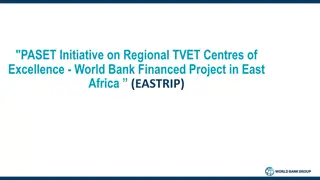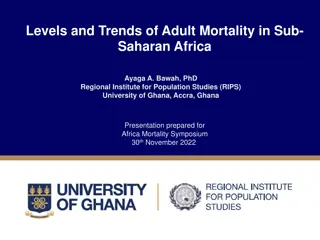Adolescent Fertility Trends in Sub-Saharan Africa: A Critical Analysis
Investigating adolescent fertility rates in Sub-Saharan Africa reveals disparities in existing measurements and raises questions about the relationship between adolescent birth rates, unmet needs for contraception, and gender equity. Utilizing data from Health and Demographic Surveillance Systems alongside Demographic and Health Surveys presents a more comprehensive view. Local-level analyses are crucial in understanding fertility changes and their implications on diverse sub-groups of adolescents.
Download Presentation

Please find below an Image/Link to download the presentation.
The content on the website is provided AS IS for your information and personal use only. It may not be sold, licensed, or shared on other websites without obtaining consent from the author.If you encounter any issues during the download, it is possible that the publisher has removed the file from their server.
You are allowed to download the files provided on this website for personal or commercial use, subject to the condition that they are used lawfully. All files are the property of their respective owners.
The content on the website is provided AS IS for your information and personal use only. It may not be sold, licensed, or shared on other websites without obtaining consent from the author.
E N D
Presentation Transcript
Adolescent fertility in 12 INDEPTH sites in Sub-Saharan Africa: is change faster than envisioned? C. Rossier, V. Delaunay, B. Schoumaker, D. Beguy, A. Jain, M. Bangha, M. Abera, G. Andargie, A. Aregay, B. Beck, K. Derra, M.Millogo, A.Nkhata, K. Siaka, M. Wamukoya, P. Zabre Scientific day "International comparisons at Ined" 30 September 2016, INED, Paris
The adolescent birth rate (ABR) Indicator of progress towards maternal health (MDGs and SDGs) More recently: indicator of progress towards gender equity (see new Gender Inequality Index UN 2010): ABR tightly linked to poor education and early union formation / poverty Indicator of adolescent overal sexual and reproductive health: associated with level of unmet need for contraception among adolescent => Contested (Hindin et al 2016): could unmet need not grow as ABR declines, depending on how it is measured (unmet need perhaps not well measured for non married women)
Adolescent birth rate 1990-2015 , world regions 220.0 Sub-Saharan Africa Asia 200.0 births per 1000 women 15-19 180.0 160.0 Europe 140.0 120.0 Latin America and the Caribbean Northern America 100.0 80.0 60.0 World 40.0 20.0 0.0 Source: UN, World Population Prospects 2015 1990 - 1995 1995 - 2000 2000 - 2005 2005 - 2010 2010 - 2015
How accurate are the current measures of ABR in SSA? In this paper, we investigate the question of the measurement of adolescent fertility rates in SSA The main source of data on fertility in the region are the Demographic and Health Surveys (DHS) We use here Health and Demographic Surveillance Systems (HDSS) data, which have contributed to the measure of mortality so far sample sizes of adolescents in HDSS sites are much bigger than what is available in the DHS data quality is expected to be better (age, missing births), and exempt of sampling biases.
Is unmet need really lower when ABR is lower? Local-level data provide a larger diversity of situations Local level analyses in a variety of contexts are needed to further our understanding of fertility change and implications of these changes => we will examine in particulat the relationship between ABR levels and measures of unmet need for different sub-groups of adolescents (married and not married according to different levels of sexual activity).
Starting year* Population 2014 Type DHS year and region 2014 Kedougou Fatick Ziguinchor 2010 Bouche de Mouhoun Center West Ouagadougou 2011-12 Sur sans Abijan 2011 Amhara Oromya Tigray 2014 Nairobi 2010 Northern Senegal Bandafassi Niakhar Mlomp Burkina Faso Nouna Nanoro Ouagdougou C te d Ivoire Taabo Ethiopia Dabat Gilgel Gibe Kilite Kenya Nairobi Malawi Karonga 1970 1962 1985 13 000 43 000 8 200 rural rural urban 1992 2009 2009 93 000 54 780 82 387 rural rural urban 2008 45 766 rural 1996 2005 2009 46 984 54 476 65 848 rural rural rural 2003 61 695 urban 2002-04 35 730 rural
Comparative work at INDEPTH Raising fundsto invite one researcher per site Open call to all sites, template for data and examination of minimal data requirements 18 sites present in Accra Most of the week devoted to construct the "core residency file" (done for INDEPTHStats, but not shared within sites) 12 sites completed the analyses after the workshop/ had sufficiently good data => No other data than fertility rates and current education
Methods HDSS : data in an event-history format: core residency file based on an entry/exit file of women aged 15 to 49, their date of birth and ID. Births and marriages (when available) were added as new events to the core residency file : data on education when available. Three sites had no or incomplete data on recent educational attainment (Bandafassi, Mlomp, Nairobi). DHS: we computed regional adolescent fertility rate for the 12 regions using tfr2 (5 last years); weights We compared in the two sources of data , - the ATB (matching years) - % population of women 15-19 by educational level (none, some primary, some secondary or more), - ratio of women aged 15 to 19 to women aged 15 to 49 - unmet need contraception, for different groups of w. 15- 19 by marital status / sexual activity
ABR, 12 HDSS in sub-Saharan Africa, varying periods 0.22 Bandafassi 0.2 Dabat Nanoro 0.18 Adolescent fertility rate (15-19) Nouna 0.16 Kilite-Awlaelo 0.14 Karonga 0.12 Mlomp 0.1 Niakhar 0.08 Ouagadougou 0.06 Taabo 0.04 Gilgel Gibe 0.02 Nairobi 0 1980 1985 1990 1995 2000 2005 2010 2015
A huge diversity: Mlomp at the level of Europe Average for SSA 2010-2015 (UN): relatively close to the highest ABR registered among our sites (Nouna, Karonga, Bandafassi) Very fast declines in some sites: Karonga, Taabo, Bandafassi
Adolescent Birth Rate 1985-2015: all of Senegal (UN WPP) and Niakhar, Bandafassi and Mlomp HDSSsites 220 200 180 births per 1000 women 15-19 160 140 Bandafassi 120 Mlomp 100 Niakhar 80 Senegal 60 40 20 0 2015 1983 1985 1987 1989 1991 1993 1995 1997 1999 2001 2003 2005 2007 2009 2011 2013
Number 15-19 Ratio 15-19 to 15- 49 ABR TFR HDSS* 2014 DHS Last survey HDSS 2014 DHS Last survey HDSS Year of DHS last survey - 1 DHS (5 last years) HDSS correct ed DHS HDSS Year of DHS last survey - DHS (5 last year s) Bandafassi 644 90 0.24 22.06 0.11 0.19 5.52 6.52 Niakhar 2121 146 0.23 25.45 0.07 0.08 0.06 6.11 6.43 Mlomp 476 103 0.23 22.97 0.02 0.08 3.50 4.66 Nouna 3862 230 0.21 16.52 0.14 0.17 0.14 5.4730 6.77 Nanoro 2229 304 0.19 0.13 0.09 0.13 0.07 4.8282 6.54 Ouagdougou 4148 317 0.23 0.24 0.06 0.05 0.05 3.13 3.26 Taabo 3851 137 0.21 0.20 0.14 0.13 0.10 5.3889 4.74 Nairobi 2577 125 0.16 0.12 0.10 0.08 2.58 2.90 Karonga 2387 968 0.21 0.23 0.14 0.17 0.07 5.3889 5.74
Comparison DHS- HDSS: 9 sites (Ethiopian sites forthcoming) The ABR is lower in HDSS sited compared to DHS region in 5 cases, similar in 4 cases Educational level of 15-19 on the whole lower in HDSS sites compared to region as a whole => when controlling for age, the gap widens Similar conclusion for the TFR.. N much higher in HDSS Does the DHS under sample "unconcerned" women aged 15-19? => ratio 15-19 lower in 3 sites (Nouna, Nanoro and Nairobi)
Context and consequences of ABR diversity among the 12 regions (DHS data)
% women 15-19 in union and ABR, 12 regions with HDSS sites, last DHS 0.25 births per 1000 women 15-19 0.2 Bandafassi Karonga Nouna 0.15 Taboo Nanoro Gilgel Kilite 0.1 Mlomp Niakhar Nairobi Dabat 0.05 Ouaga 0 0 10 20 30 % in union 40 50 60 70
% Women 15-19 with secondary schooling and ABR, 12 regions with HDSS sites, last DHS 0.25 births per 1000 women 15-19 Bandafassi 0.2 Karonga Nouna 0.15 Taabo Nanoror Gilgel Gibe Kilite 0.1 Mlomp Dabat Nairobi Niakhar 0.05 Ouaga 0 0 20 % 15-19 with secondary education 40 60 80
Adolescent birth rate and unmet need for contraception among women 15-19, 11 regions with HDSS sites, last DHS % women 15-19 with an unmet need 20 18 Bandafassi 16 Taabo Nouna 14 12 Nanoro 10 8 Dabat Gilgel Kilite 6 Niakhar Mlomp Nairobi Ouaga 4 2 0 0 0.05 0.1 0.15 0.2 0.25 births per 1000 women aged 15-19
Adolescent birth rate and share of women 15-19 who have premarital sex 11 regions with HDSS, last DHS 60 % women 15-19 not in union and ever Taabo 50 40 sexually active Nairobi 30 Ouaga Mlomp 20 Nanoro 10 Nouna Dabat Bandafassi Kilite Niakhar Gilgel 0 0 0.05 0.1 0.15 0.2 0.25 Births per 1000 women 15-19
Adolescent birth rate and unmet need for contraception among women who have premarital sex 70 % unmet need among unmarried women 60 Niakhar 50 ever sexually active 40 Bandafassi Nouna 30 Taabo Kilite Nairobi 20 Nanoro Ouaga Gilgel Mlomp 10 Dabat 0 0 0.05 0.1 0.15 0.2 0.25 births per 1000 women 15-19
To sum up context / implications Relationship with marital status and educational level as expected Strong link with unmet need 15-19 No relationship with % engaging in premarital sexual activity Strong link with unmet need among women 15- 19 who are having premarital sexual activity => This unmet need seems related to contraceptive use / unmet need among married adolescent and not to how widespread premarital sexual activity is Not enough data in the regional DHS samples























